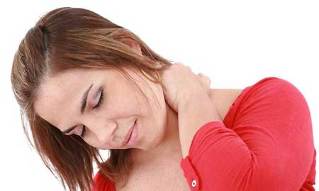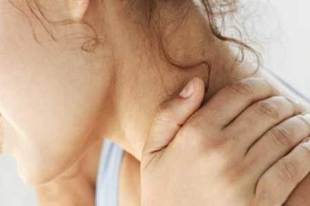In the world there are a few diseases that belong to a person only because he is a man. For example, vascular lesions and deposition of their walls, cholesterol is also found in the animal world. Symptoms of degenerative disc disease of the neck can be confused with symptoms of other diseases. Increase in blood pressure is characteristic of all warm-blooded animals. Improper nutrition can lead to exhaustion and lack of protein and vitamins, and chicken, and an elephant, and clam, and the wrestler of freestyle. But osteochondrosis refers to diseases that can be proud of the only people that even his closest relatives – the primates, the disease is virtually absent. Let us examine the manifestations of symptoms and methods of treatment of degenerative disc disease of the cervical spine.

Cervical osteochondrosis, what is it?
Osteochondrosis of the cervical spine — disease, bone and cartilage, which belong to the dystrophic — degenerative. The underlying disease (malnutrition cartilage), and then its destruction or degeneration. In fact, osteochondrosis primarily suffer from the cartilaginous intervertebral discs, and then "snowball" is complemented by the reaction of the bone (osteophytes), the appearance of hernias protrusion and root symptoms, the occurrence of instability of the cervical spine, as well as severe headaches and chronic muscle spasm of the deep muscles of the neck, with the disorder of regional blood circulation. The cause of osteochondrosis and intervertebral discs in the cervical or cervical – thoracic only one: it is a historically established position in the vertical direction in person. No cats or cows or hippos do not have such a constant axial load in the vertical direction is located at the back, the spine is relaxed, "loose" state, and the spacers feel comfortable. Person also the development of cervical degenerative disc disease exposure to the following factors:
- Often is in the upright position;
- Injuries and rapid movement, head shots, for example. low ceilings;
- To carry the goods on their shoulders, in some countries – of the head;
- The lack of active movement. It leads to weakness of the muscular system, which is critical in the cervical spine.
Also other factors include wearing in winter, heavy collars and fur hats, which objective is to "serve mode", reducing fluid intake, causing dehydration of the primary cartilage. This increases the fragility of the disc and calls "the lama" (narrowing thickness), reducing the buffer of the elastic properties. In his youth, degenerative disc disease, it can lead to a violation of posture written assignments and computer work. Congenital changes in the spine, for example, scoliotic deformity of the thoracic spine. Remember, the higher on the spine the more intense pulse, which can have a detrimental effect, similar to the "whiplash" injury. Therefore, fault or violation of compensatory mechanisms, which protect our skull excessive concussion, also lead to degenerative disc disease of the cervical spine. Here are the reasons:

- Flat feet, as well as longitudinal and transverse. The arch of the foot, devoid of softness, unable to keep the intervertebral discs in the cervical concussion and fractures;
- Background degenerative disc disease of the lumbar spine. If the elasticity of the lower back is broken, do not expect good protection of the cervix.
Symptoms of degenerative disc disease of the cervical spine
Signs of osteochondrosis of the cervical spine is very different, but all of them can be divided into local and remote screen. Local symptoms of cervical degenerative disc disease are:
- Simply drag-and sore muscle pain, low intensity, worse after prolonged sitting, for example, when working in the office and the computer;
- Crunching when moving the neck. Most strongly it is felt, when performing the morning exercises, in that case, if you plug your fingers in your ears. Then the bone conduction sound exceeds the air, and when turning the neck, a crunch is heard well. This symptom indicates the appearance of osteophytes, which violate the congruence (fitting accuracy), cartilage and vertebrae;
- Pain in the neck, both when driving (mostly sharp). These pains are called the Servicio, by analogy with "lumbago" in the back, which is called lumbago. Such pain for the treatment of radicular manifestations of osteochondrosis. They arise when a sudden concussion of the nerves, which occurs with laughing, coughing, sneezing, straining. This pain reminiscent of neuralgia, and similar to an electric shock in its power and suddenness. Most often it occurs in the thoracic spine;
The remote characters are:
- Headaches osteochondrosis. Appear calm, reminiscent of the "helmet" or "helmet", are often symmetrical. The intensity is low, they may be related to the movement, but not necessarily. Often they "go" in the head, neck, and accompanied by lack of exercise.
- Conductive disorders of sensitivity. Often arise at night waking, the person feels that he has numb fingers. Most often it is the little finger and half the ring finger side of the little finger. To restore sensitivity, you need to move the hands, neck and posture change.
This is due to a pinched nerve in the cervical plexus places the output of the nerves. It is important that the roots are broken most of the spasserovannye of the neck muscles, which are close to the vertebrae. Cervical degenerative disc disease, the symptoms of which, we understand, can be a complex instability of the cervical spine. The height of all intervertebral discs in the cervical spine is uniformly reduced, and the neck is "abnormal movement", or the tendency to pain and different strains of the movement. When this situation happens often appearance is a violation of the nerve root and increases the risk of protrusion and hernia.

The role of muscle spasm
There is a secondary muscle spasm, which is called myofascial — tonic syndrome. This condition can occur in many different parts of the spine, anywhere where there is striated muscle. As a result of reducing the height of the intervertebral disks and the growth of marginal osteophytes, the muscles are "tightened", and their blood circulation becomes weaker. Accordingly decreases and the venous outflow. Such a situation leads to swelling of the muscles and their chronic spasm, which is manifested by pain and stiffness in the neck and back.
Diagnosis of cervical osteochondrosis
In typical cases, degenerative disc disease of the cervical spine occur in the above symptoms. Therefore, the main step in the diagnosis has been and is still the patient's identification information, establishing the presence of muscle spasm associated with simple palpation of the muscles along the spine. To confirm the diagnosis of osteoarthritis using radiographic studies:
- X-ray of the cervical spine, although the functional tests in flexion – extension does not show the cartilage, as tissue transmits x-ray radiation.
Despite this, the location of the vertebrae, it is possible to make General conclusions about the height of the intervertebral discs, overall straightening of the physiological curvature of the neck lordosis, as well as the presence of regional tumors of the vertebrae during prolonged irritation of the surface of the brittle and dehydrated intervertebral discs. Functional tests help to confirm the diagnosis of instability of the cervical spine;
- Magnetic resonance imaging and x-ray computed tomography is shown to clarify the internal structure of cartilage and the formation of protrusions and hernias.
So accurately exhibited the diagnosis of complications, and the resulting scan is a manifestation of the operative treatment of hernia in the neurosurgery Department.
Treatment of cervical degenerative disc disease, drugs
For the treatment of degenerative disc disease of the cervical spine has always been complex: at first, to remove the acute pain drugs, and then after the cervical osteochondrosis (to reduce pain) recession, to join the physiotherapy and massage techniques, and after cupping this acute phase starts secondary prevention, that its aim is to prevent recurrent exacerbations. Sometimes the patient is prescribed Spa treatment. The main groups of drugs to relieve acute pain are:
- Non-steroidal anti-inflammatory drugs. Limited to inflammatory component;
- Muscle relaxants Central action . Reduce the tone of spastic muscles, reduce pain, stiffness in the muscles;
- B vitamins – contribute to the improvement of the trophic nerve tissue;
- The drug improves the capillary blood microcirculation — improve the outflow of and normalize the function of muscles.
These funds is assigned to, or under, or the muscle increases the efficiency. The purpose is to relieve acute pain. Then after 2-3 days go to the reception of tablets, actively use the creams or gels that are rubbed into the neck and back. In the second stage to join the physiotherapy – electrophoresis with vitamins and hydrocortisone, massage, underwater traction control and shower, iglorefleksoterapevta techniques. Sometimes prescribed drugs – chondroprotectors, but when they are taken inside their efficacy has not yet been demonstrated. Only intra-articular introduction of the deputy members of joint fluid can reduce the crunch to facilitate movement and eliminate pain. But osteochondrosis, this technique worked on large joints, is almost never done. Surgical treatment is performed in severe compression of the bulge or hernia in the sensory or motor root. Indications for surgery are intractable pain is expressed during the month, a troublesome treatment, or the progression of weakness in the muscles of the arms, to expand the area of sensitivity and confirmation of the diagnosis of the bulge and disc herniation on MRI or CT.
Exercises with cervical osteochondrosis
Gymnastics in osteochondrosis of the cervical spine is not that other, as a rational adherence to exercise and maintain a healthy lifestyle: osteochondrosis found in all without an exception of people, starting from childhood, and even in some places it is considered a "normal variant". Because there is no such person, especially in adulthood would not be signs of degenerative disc disease, the goal of gymnastics is to leave only the objective radiological signs of the disease, and remove all complaints. It is known that even the elderly and the elderly may present a complaint to his neck and back, but only if you have enough time prevention.
Prevention of cervical degenerative disc disease
Maybe, for example, degenerative disc disease can bring prevention, which will be visible to all, and as a result we get rules of a healthy lifestyle. Here they are:

- Free movement, no excessive weights, exercises without a load, just the weight of his body;
- Drink plenty of pure water, because the age of cause dehydration of the cartilage tissue;
- Preservation or normalization of weight;
- The occupation of such loads, which reduces the load on the back (swimming);
- Avoiding harmful habits;
- Alternating mental load with physical. Every hour and a half of intellectual work is recommended to change the activity of the physical activity;
- Prevent hypothermia of the neck, back, waist, especially in spring and autumn.
Just by following these simple recommendations, osteochondrosis of the cervical spine, symptoms and treatment, which we have studied, not to disturb you for years.
































